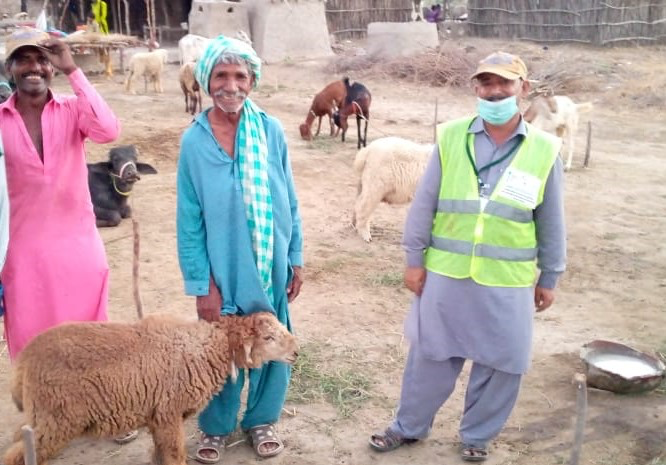
Larr Humanitarian Development Program, in collaboration with international partners, has trained 40 unemployed young men in Badin district to make Livestock Extension Services available in the drought-hit areas.
By Sanwal
Some 40 kilometers away from the main town of Badin, Manzoor Ali Nohrio, a 36 years old activist, is extending his services to secure livestock, which is the second major primary source of income in rural areas of Sindh. Livestock in rural areas suffer from reduced fodder and disease outbreaks during droughts. Though livestock ailment is a usual phenomenon in Badin, it gets severe when there is drought situation and extension services as well as treatment facilities are not in reach of the poor farmer who lives far away from towns and cities. Lack of animal husbandry services in the villages aggravates the situation and causes a devastating blow to the rural economy.
To secure this resource against disasters, Action against Hunger (ACF International) together with its implementing partner Larr Humanitarian Development Program (LHDP) has trained a cadre of 40 unemployed young men in Badin district to make Livestock Extension Services (LES) readily available in the drought-hit areas, Manzoor Ali Nohrio is one of them.
Manzoor Ali, father of two, lives in village Bachal Nohrio Taluka Tando Bago district Badin, Sindh. He is an intermediate unemployed young man who has now an aim in life to work for the livestock sector. Though he cultivates a small piece of agricultural land to survive, it is too meager to manage daily needs of his family. LHDP selected him for a month-long training course on livestock management in March 2020. The course was organized at Sindh Agriculture University Tando Jam, wherein he proactively took part and learnt best practices of livestock care and cure.
The month-long Community Livestock Extension Worker (CLEW) course contained basic principles of livestock management, shade management, nutrition, fattening of animals, artificial Insemination, bread improvement, seasonal diseases and their control techniques, milk and By-products, feed and fodder management and fodder conservation.
After completing the training course, he collected data of the livestock in his village and surrounding areas and started introducing himself as livestock worker with the help of the SKALA project. “I have extended my services to the disaster affected farmers in around 30 villages and have so far vaccinated more than 4000 animals charging Rs.200 per animal”, says Manzoor.
Though there is little trend of livestock vaccination in the villages, it is getting improved as LHDP is mobilizing communities for the same for the last two years, he said.
Manzoor has a motor bike, which he goes with to visit the communities with a kit. The CLEW kit was provided to him by the SKALA project, which contains necessary first aid medicine and instruments such as drenching gun, syringes, gloves etc. “Approximately, I earn Rs.500 to 1000 a day on average”, Manzoor happily informs. Monthly average income he earns is around Rs.15000 to 20,000.
Sharing his experiences in livestock management, Manzoor said that it is necessary that the one must have skills of diagnosing the diseases and if he succeeds in it, he can administer it. “In complicated cases, I also seek assistance of the Government livestock Department’s experts too over the phone. Besides, instruments, cell phone is an important tool, the person must have in order to be connected with the clients and the service providers”, says Manzoor.
“My cell phone has eased my job. I also educate farmers on livestock fodder and water requirements, seasonal diseases, silage making and birth administration”, Manzoor added.
In Badin area, which is prone to sudden onsets, livestock is the only asset people have that they sell out in difficult times. And if it is lost, the farmer can only feel the pain. Badin district’s current livestock population is 1573,510 heads, which were 1,140,122 in 1998. It is 12 percent less than the human population, which approximately is 1,804,516. Surprisingly there is only 29 staff that includes 12 Veterinary Officers, 15 stock assistants and two district officials for the management of this important rural economic sector in the entire district. Though LHDP and ACF have fielded a cadre of 40 CLEWs in the district, a lot has to be done to secure this second primary major livelihood asset in rural areas. For effective livestock management there should be at least one livestock center at union council level where a qualified person should serve the people.
_________________